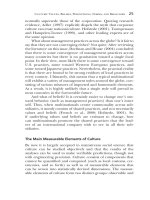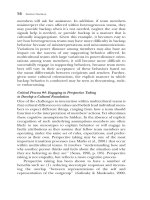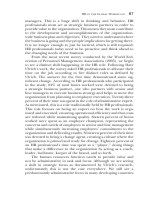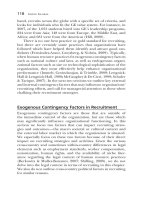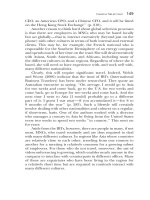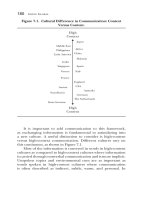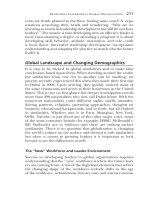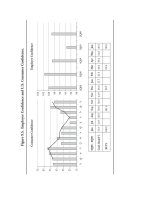Practical Applications and Recommendations for HR and OD Professionals in the Global Workplace_9 doc
Bạn đang xem bản rút gọn của tài liệu. Xem và tải ngay bản đầy đủ của tài liệu tại đây (515.3 KB, 31 trang )
Developing Leadership in Global Organizations 211
roots are firmly planted in the West, leaving some non-U.S. orga-
nizations scratching their heads and wondering, ‘‘Why are we
investing so much in leadership development but still do not have
leaders?’’ The answer is that developing into an effective leader is
more than attaining a degree or attending a program; it is about
developing skill, behavior, attitude, motivation, and role—with
a local flavor. Successful leadership development incorporates
understanding and adapting the practice to match who the future
leader is.
Global Landscape and Changing Demographics
It is easy to be tricked by global similarities and to make false
conclusions based upon them. When traveling around the world,
the similarities from one city to another can be startling; my
parents recently experienced this when they made their first trip
to Dubai in 2008. Upon arriving, they quickly noticed many of
the same restaurants and stores as their hometown in the United
States. This is true on first glance but deeper investigation reveals
more than 200 nationalities who now call Dubai home. With the
numerous nationalities come different sights, smells, attitudes,
driving patterns, religions, parenting approaches, thoughts on
business, educational backgrounds, and so forth, but all clothed
in similarities. Whether one is in Paris, Shanghai, New York,
Delhi, Nairobi, or just about any of the other major cities, many
of the same consumer brands (for example, HSBC, McDonald’s,
BP, Starbucks) are in evidence and there are striking surface
similarities. There is no question that globalization is changing
the world’s culture on the surface and dressed it with similarities
but when it comes to growing leaders it is important to look
beyond to see the differences as well.
The ‘‘New’’ Workforce and Leader Environment
Success in developing leaders in global organizations requires
understanding that the ‘‘new’’ workforce is where the future lead-
ers are coming from. A few of the high-level elements that reflect
the changing shape of the workforce include shifts in the age
of the workforce, urbanization, literacy rate, and microeconomic
212 Going Global
structure. Each of these in turn shapes what one should consider
and how to approach leader development.
• According to the 2008 U.S. Census Data on World Population,
40% of the people in emerging-market countries are under the
age of 20 and the total youth population in the emerging mar-
kets is eight times larger than in the developed markets. This
means that there are significantly more young and inexperi-
encedworkersandleadersindevelopingnations.Anobvious
challenge for leadership development experts in those areas,
then, is that the potential pool (that is, the future leaders) will
have less practical experience to draw upon. Because they will
not have worked their way up through the ranks and mastered
leadership challenges along the way, more remedial action may
be needed. This creates a challenge for organizations and cur-
rent leaders as they need to modify their acceptance of what
are the qualifications for leadership position. Additionally, this
means that mode of leader development will be dependent on
mentorship and the localized practices of assuming a corporate
patriarchal development model.
• Every second, two people move from the rural countryside into
one of the world’s 496 cities with a population in excess of one
million, and, according to the United Nations, 52% of the world
now lives in an urban setting. In practical terms, this translates
into a massive influx of uneducated and unskilled (at least for
the urban setting) workers. And though leadership develop-
ment programs may have historically (that is, since immediately
following WWII) dealt with effective leadership for this type of
population, the Western-centric programs are currently geared
toward modern nonagrarian workers. This a challenging envi-
ronment on the global scene as it requires understanding a new
working class who has not had exposure to formal organiza-
tional performance dynamics.
• The literacy rates in the West have been stable for generations
whereas in the emerging markets they have been growing
steadily. This is truly a great step in the right direction, but
it is important to remember that literacy cannot be taken for
granted. This has practical implications for leaders, as some of
Developing Leadership in Global Organizations 213
the ‘‘new’’ workforce and their families may not be literate and
steeped in organizational traditions or rhythms.
• Finally, one out of six people today are living on less than $2 per
day, and many live in the shadow of one of the world’s cities
with a population of one million or more. For leaders, this is
a staggering number of potential employees who are focused
more on survival than anything else. Such concepts as inspi-
rational leadership, self-actualization, and communication,
though important in leadership development curricula, mean
little to employees at the bottom of today’s food chain. This is a
paradigm-shifting process for leaders, as they have to align their
level of thinking on needs with the considerations of the urban
poor who are eagerly entering the workforce.
How Do These Differences and Distinctions Relate
to Developing Leaders?
On a daily basis, a scan of the news headlines reveals how different
regions view the work of leadership. In some, leadership is synony-
mous with power. Consider the historic or modern-day warlords,
dictators, and the concept of ‘‘Big Boss.’’ In others, leadership
is synonymous with vision, dignity, and courage. Whatever the
view, it is clear that one’s concept of leadership is heavily reliant
upon his or her culture or region of origin. In a similar fashion,
many organizations (consciously or not) formulate ideas about
leadership at their home office, and it is these homegrown ideas
that so often underpin their leader development programs. How-
ever, these home office perspectives are not necessarily universal
and can have limited impact on the ‘‘new’’ global workforce. For
example, many leadership development programs have recently
added the topic, ‘‘How to lead different generations’’ and have
adopted the popularized terms, Baby Boomers, Gen X, Gen Y, and
so forth. These terms resonate in North America but have limited
meaning in countries that did not experience a post–WWII boom
in births, let alone those that did not exist at the time. China,
by contrast, has a very different leadership challenge that also
has implications for training. Specifically, there is an absence of
highly qualified leaders among the age demographic that would
214 Going Global
have been in college during the time of the Cultural Revolution,
when universities were closed by the Chinese government. Both
of these are extreme examples, but the point is that when adopt-
ing an approach and structuring content for leader development
programs, global organizations need to consider the local demo-
graphics and history when designing curricula to develop leaders.
Thus, you might say that leadership development happens
at the point where anthropology, sociology, and psychology con-
verge with organizational behavior. Cultural norms and habits are
embedded from birth and are built through the formative years
and into adulthood. Developing leaders is complex in a single soci-
ety, let alone globally, and few organizations have fully leveraged
the potential impact that can come through their development
programs. All over the world, people are very different—they
come from different backgrounds with unique experiences—and
the local societies are at different stages educationally, economi-
cally, and developmentally.
The global landscape can be summarized in the notion of
difference—people are different, companies are different, coun-
tries are different, and to excel in global leadership development,
these differences have to be leveraged in the creation of appro-
priate methods that replace the reliance on a ‘‘one size fits all’’
global leader development program. Leadership development
needs to connect personally with who the leader is; this happens
best through examples and approaches from the leaders’ heritage
and discipline, specifically merging local industry with the home
office leadership environment. Organizations should focus their
attention on how leadership development should be happening
in their environment and maximize the leadership potential in
every culture. What inspires and instructs a leader counts in the
development process, and it needs to allow for variation in the
global programs.
Practical Recommendations for Global Companies
Developing executives who are equipped to work in a global
environment and developing leaders who are on the other side of
the world pose a significant challenge for leadership development
experts today. As this chapter has pointed out thus far, it is
essential to understand not only the universal truths—the ‘‘what’’
Developing Leadership in Global Organizations 215
of leadership but also the context-specific and variable ‘‘hows’’ of
leadership. However, this is easier said than done. The reality is
that a lot of money and time are invested in leadership devel-
opment with limited ROI. Given this track record, what should
organizations do? For leadership development efforts to deliver
the desired results, a successful comprehensive and truly global
approach to organizational leadership development should:
(1) foster an understanding of the uniqueness of experience and
environment, (2) maintain afocuson cultural heritage and organi-
zational future, and (3) adapt the leadership model and approach.
Understand the Uniqueness of Experience and Environment
Just as streetwise business operators get to know the customer
and sophisticated organizations invest in consumer insights,
leadership development specialists need to get to know who the
participants are. Because people are different around the world,
organizations need to look beyond their current hypotheses and
explore the causal factors that shape how leaders develop, with
the purpose of constructing an effective approach to leadership
development. Four elements that need to be considered when
understanding the uniqueness of experience and environment
include the leaders’ unique backgrounds, their thought processes,
their home societal structures, and the dominant religion of their
development cultures.
Leader’s Unique Background
Leadership development specialist need to scrutinize and discover
why the differences exist and understand their assumptions as
they influence how people think and behave and thus grow in
their leadership capability. This requires leadership development
specialists to set aside existing notions and constructs about their
specialties while they probe the local markets to understand who
the people are and how they develop. These three fundamental
questions need to be contemplated in the exploration process:
1. Why do leaders learn?
2. How do leaders learn?
3. What do leaders need to learn?
216 Going Global
When addressing these questions organizations should con-
sider individual leaders or tightly aligned markets rather than
contemplating universal answers for leaders on a global level. Two
risk factors are involved in this practice: (1) this activity is heavily
reliant upon anthropology and sociology, a skill set not tradition-
ally taught or practiced in organizational leadership development
departments, and (2) without broad international experience as
an expatriate including significant experience in various coun-
tries, it is difficult to set aside individual experiences and be able
to question why things are as they are in a particular culture—let
alone draw conclusions that affect leadership development.
For example, in the midst of a major leadership development
effort, a leading telecom company with an operating office in
one of the emerging markets realized that the leaders in the
program came from numerous backgrounds. In this particular
operating company, they had 35 different nationalities and all
but 1 nationality was working outside of its home office. Their
leadership development specialist, who had extensive expatriate
experience, recognized this reality and hit the pause button to
explore what this meant for how they lead and what it will mean for
how leaders will develop. They explored the three fundamental
questions mentioned earlier and concluded that they needed to
take a deep look at their leaders’ backgrounds and adapt their
global program accordingly.
Thought Process
Human cognition is not the same all around the world, and
at the most elementary level people in the East and West have
different basic thinking approaches. Psychologists have assumed
universally that Westerns and East Asians have maintained very
different systems of thought. For example, Westerners have a
strong interest in categorization, which helps them to know what
rules to apply to the objects in question. And they rely on logic to
play a role in problem solving. Conversely, East Asians attend to
objects in their broad context and how they relate to one another.
The need to explore locality in relationship to leadership is
apparent through this description of the Western and Asian basic
thought processes. Leadership development specialists would be
Developing Leadership in Global Organizations 217
wise to consider the system of thought as they explore the leader’s
background.
This understanding will aid organizations’ efforts to maximize
the investment and results from leader development activities. For
example, if a company that is based in China and has operating
offices throughout Europe and North America decides to export
its home market leadership development program to all of its
global leaders and managers, it needs to allow for the different
systems of thought in order to leverage the natural abilities and
thinking processes of the leaders in Europe and North America.
Social Structures
Social structures are also distinct between various cultures and
environments, and they do affect how a person develops as a
leader. The way in which groups relate to each other is based
on relatively enduring patterns of behavior and relationships
within social systems. Norms become embedded into social systems
in such a way that they shape the behavior of leaders within
them. In and of themselves, social structures are very complex.
This complexity intensifies when attempting to cross cultures or
integrate various social norms and patterns.
Religion
As a developmental consideration, religion is more than an
approach to spirituality. Unlike the Western idea of the world
being divided into two comprehensive domains—one sacred and
the other profane—on a global landscape religion presents a
common quality for societal character. Religion is a communal
system of belief focusing on a system of thought from which come
moral codes, practices, values, institutions, tradition, and rituals.
Leadership specialists need to understand the broader impact
of ‘‘religion’’ on people as members of society. Religion shapes
personal practices and group rituals stemming from shared con-
viction; it is a ‘‘way of life.’’ Unlike the homogenous impact of
religion when operating in a single market or across European
and American markets, on the vast global front the breadth of
religious impact on how leaders develop needs to be sought out
218 Going Global
and understood. Additional thoughts to consider when exploring
a society include:
• What is the societal (and parental) support for development
and why is it as it is?
• What are general beliefs and what stories shape them?
• What are the learning habits and why are they as they are?
• What is the educational model and approach?
• What does an individual’s experience actually include?
• Individual’s cultural background and what created the culture.
• What is the perceived value of learning to local culture?
• What developmental patterns existed throughout ancient and
modern history?
• Where is the culture in its current life cycle?
• How were the potential leaders parented and how does author-
ity act?
• What types of noneducational activities are relied on in the local
culture that build leadership habits?
Leadership development specialists need to have the skills of
great connoisseurs; they need to become fully acquainted with
and appreciate the differences between the various cultures. Over
time, they will develop a taste for both views—the home office
and their leaders’ backgrounds.
Maintain Focus on Cultural Heritage
and Organizational Future
In addition to understanding the uniqueness of experience and
environment, it is the role of the leader development specialist
to understand the backgrounds, to remove barriers, and to build
a bridge between the cultures of the leader and the organization
so that they can graft together the local identity with the multina-
tional company’s environment. Success resides in knowing both
sides and how to connect them. One of the more important
elements in grafting the leader’s identity with the company’s
environment is for the development specialists to understand
the depth and development of potential leaders’ societal back-
grounds. This will facilitate bridge building and help leverage the
most effective development approaches.
Developing Leadership in Global Organizations 219
Most global organizations hold the unconscious belief that
potential leaders:
• Are educated, most likely through public education, in a class-
room that utilized active learning
• Have an understanding of the idea of organizational life as it is
constructed via extracurricular activities at the elementary level
and supported in most social interactions
• Have a consistent underpinning stemming from the influence
of a Judeo-Christian ethic absorbed through educational pro-
grams and cultural rhythms
• Will pursue and be supported to develop as leaders
• Have an understanding of operations from their first jobs held
• Operate from tightly aligned commonalities with coworkers in
their organization
But when the company explores the global settings, these
unconscious beliefs most probably do not align with those of the
regional cultures. Theories or hypotheses about environment and
background need to be tested through behavior and then modi-
fied depending on the outcome of the testing. The uniqueness of
individual experiences creates the uniqueness of personality. An
individual’s hypotheses about his or her environment not only are
a basis for describing the environment but also seriously influence
the way the individual behaves toward the environment. Suc-
cess in leadership development comes as organizations are able
to graft the environments and backgrounds together. Attention
needs to be given to maintaining focus on the cultural heritage
of the leader and the organization’s future while bringing the two
together.
Adapt the Leadership Model and Approach
Finally, leadership development activities should be largely influ-
enced by society and the dynamics of the current workforce.
Thus, the next step after compiling the leader’s dossier is to ana-
lyze the existing leadership development activities and discover
how they can be modified or adapted to maximize the investment
and leadership potential in the various markets. This is the point
220 Going Global
where organizations should understand the universal components
and explore the factors that need to be understood in order to
‘‘localize’’ and shape the leadership model.
Operating companies around the world express that their
home offices have difficulty in that they have researched and
invested heavily in current programs, yet the field offices know
that thee programs need to be modified in order to have a
greater impact. If a global organization is serious about developing
leaders, it will need to recognize the priority of this approach and
make the necessary adjustments.
Middle East Case Study
When it comes to leading in the Middle East, people often ask,
‘‘Is it any different than leading in another country or region?’’
The answer is a resounding ‘‘Yes!’’
For anyone working in the Middle East this is a question
that cannot be ignored, as it is foundational for business success.
Looking around the globe it is clear that leadership initiatives
are not the same, nor should they be. It is a grave mistake to
think that you can import and export ways of leading in the same
way that countries import and export oil.
Successful leadership development requires that you first iden-
tify the rhythms and nuances that are present in that culture.
Next, focus on understanding the leadership need(s), and estab-
lish where they originated from and why they are as they are. Only
then should you put energy into seeking the solution of how to
develop the leaders. This is especially true in the Middle East,
where people are mistakenly importing Western approaches to
leadership development without giving consideration to the local
cultural rhythms.
Consider a recent example from Beirut, Lebanon, where a
training course in time management was being conducted to
rectify the notorious problem of arriving late for appointments
and events. On the surface, it is easy to think that all time
management skills around the world are similar. So the western
training company reached into their toolbox to fix this perceived
problem. In the midst of their training, the solution was, ‘‘if
you make better use of your time then you will be on time.’’
Developing Leadership in Global Organizations 221
Knowing Lebanese culture, I found this to be laughable. Even
more hystericalis how the trainer proceeded to teach the Lebanese
managers to use their time. The solution was to turn off mobile
phones and only answer calls for two hours each afternoon. At that
suggestion, one could see the Lebanese managers’ eyes glaze over.
Why? This development solution had a lack of understanding
of the local culture and it was addressing a problem that was not
really there. In Lebanon (and most of the emerging markets), the
mobile phone is the dominant method of communication and a
central component of life—they never turn off or ignore their
mobile phones.
This lighthearted example is meant to emphasize what can
happen when there is a lack of understanding that situations and
cultural rhythms are different and that leadership development
solutions need to be rooted in the local society. Why do people
come into the Middle East (or for that matter any part of the
world) and propagate their solutions without an understanding
of the local market and needs?
At the time of my research, there was a deep sentiment that
Western leadership development solutions would not work in
theMiddleEast,yetmanypeoplewerestillreadingWestern-
oriented business books and attending Western-based leadership
seminars in search of success even though the content could not
be fully implemented. Why would this be? In order to develop
leaders successfully in the Middle East, you have to understand
the culture, you have to know what influences it, and you should
lead accordingly. When addressing the Middle East, it is critical
to look into its history and notice the rich culture and massive
achievements.
Successful leadership development in the Middle East (ME)
requires an understanding of the elements that influence the
society. This case study shows an ME-specific model of leadership
development called the ‘‘Patriarch Model.’’ If applied in the
right context, this model will be the framework for successful
leadership development in the Arab world. It is important to note
that there is no such thing as ‘‘one’’ Middle East or Arab world.
This region is made up of more than 15 countries, half a dozen
different religions, and countless regional- and tribal-specific ways
of doing things. So even in a tightly aligned geographical region,
222 Going Global
there are differences to be considered. Although there are many
differentiators, a quick look across the Middle East will reveal a
few commonalities. This case study utilizes the commonalities in
identifying the elements of influence.
Elements of Influence in the Middle Eastern Society
The most important thing to do when leading in the Middle East is
to become familiar with what has and does influence the culture.
The following influences—the family, Islam, family business, and
colonialism—have shaped Arabic business into what it is today.
Likewise these elements shape the way people develop as leaders
and should be apparent in a global organizations program.
Influence of Family: Patriarchal and Loyal
Unlike in the West, the influence of family in the Middle East is
very strong and has a tremendous impact on how people lead and
what employees are looking for in their employers. At the very
least, organizations need to be aware of this influence.
Why does the family dynamic have such a powerful influence
in the corporate settings? Because the Arab world is a patriarchal
society and family focused. In this society, the father is the central
figure and he wields a great amount of authority. In the traditional
Arab family home, there is a healthy respect and reverential fear
of the father as the family looks to him for leadership. It is also
typical that this leadership will pass on to the eldest son. The
patriarch in the family understands he has the responsibility for
the family or tribe and does not take it lightly.
The business environment is a facsimile of this family structure.
Employees look to their boss for strong leadership and expect to
experience what they would at home. At the same time the boss
embraces his responsibility for the stewardship of his employees.
IntheArabhomeitiscommontohavecentralizedpower;
however, in the business world this often causes problems and
creates blockages for the work. The bottlenecks in the decision
making, the minimal delegation, and the vast amount of task-
oriented leadership are by-products of the misused patriarchal
patterns. The influence on the patriarchal family structure can
be seen in the structure of organizations in which top-down
Developing Leadership in Global Organizations 223
authority is the norm. The natural outcome of centralized power is
control, and this controlling mentality will limit a leader’s ultimate
influence and success. The tight locus of control and power that
is experienced in the business context comes from mimicking the
home style of leadership. For an organization to develop leaders in
the Middle East, it is essential to understand where these patterns
come from and why they exist; this understanding is foundational
to success.
Group Orientation and Relationships
There is also a strong group orientation in the Middle East. An
Arab family is a very tight-knit group of people and the extended
family is the locus for most social interaction. They live life out as
a group, so much so that it is quite common to find cousins as
best friends.
How does the group orientation work in a patriarchal setting?
On the surface these practices seem to be paradoxical but in
reality they work well together. Even though legitimate authority
rests ultimately on the apparent absolute power of the patriarch,
he nonetheless takes account of family opinion when making
decisions.
Even with his given authority, the good patriarch creates a
consultative environment where the group orientation supports
a group approach to making decisions. The business context
is both hierarchal and consultative. This consultative structure
offers the basis for understanding how decisions are made in the
Arab world. It is fundamentally different than in the West, which
primarily endorses individual decision making.
The family takes an active role in deciding whom to marry,
where to work and live, and even what type of car to drive, and
so forth. Stemming from the family nature of decision making
comes the consultative approach to decision making in Arab orga-
nizations. Westerners working in the Middle East often incorrectly
criticize their Arab counterparts for not making a decision; they
do not understand that the reason for this behavior is based on
historical decision-making rhythms. They are accustomed to being
part of a group decision-making process and then looking to the
patriarch to make the final decision.
224 Going Global
The impact of relationships is also felt in the way that business
is carried out. In the Arab world, business is based predominantly
upon relationships. In this highly relationship-oriented society
each family works toward the long-term accumulation of position,
prestige, standing, relationship, and respect.
Honor and Loyalty
Because of the relational society comes an intense focus on loyalty.
It is expected and often guaranteed as leaders surroundthemselves
with subordinates that they can trust.
Another difference in the Arab world is the practice of giving
and preserving honor. The influence of the family is central to
understanding the Arab manager’s use of time during the working
day. When a close family member appears at the office of even a
very senior manager, it is regarded as improper for the demands of
organizational hierarchy to take precedence over the obligations
due to family. In other words, he is choosing to give honor to his
family before giving priority to his work.
Leadership is a complex phenomenon in Arab organizations
and is related to the ideal of honor. This is challenging concept
for western-oriented managers because the West is a guilt-or-
innocence culture where something is either right or it is wrong.
The Arab world has a very different focus: it is an honor-or-shame
culture. These two very diverse orientations generally shape the
way work is conducted.
Influence of Islam
When trying to understand the business culture and provide
leadership in the Middle East, it is important to take into account
the influence of Islam. This is not speaking of the influence of the
local mosque, but the cultural underpinning of Islam in society.
Similar to the way the West has been shaped by the practice of
Christianity over centuries, the Middle East has become what it is
from the influence of Islam.
In the Arab world it is believed that Islam is more than a
religion that concerns itself merely with the spiritual aspects of
life. Islam is literally a way of living that embraces the spiritual,
Developing Leadership in Global Organizations 225
moral, social, educational, and economic aspects of life. Islam
does not separate religious and state authority in the way that is
usual in the West. It is a religion of practice and is publicly visible
rather than being only a private inner belief. Unlike the private
western practices of religion, the business environment through-
out the Middle East is deeply influenced by Islamic teaching and
practice.
Community
The idea of group orientation and relationships does not merely
stem from the influence of the family. Unity is an Islamic practice
that is expressed in the concept of the ‘‘ummah.’’ This identifies
the community of all believers who are joined as they touch the
ground during prayer. The ummah is universal and indivisible,
representing in a real sense a ‘‘body.’’ This idea clearly proposes a
different positioning for individuals in relation to other individuals
collectively as a group. Value comes from participation in the
ummah, rather than from individual practice.
The concept of group is very strong in Islam and throughout
the Arab world. This strong cultural element pours into the
business environment. And it must be understood in order to
successfully understand how leaders develop in the Middle East.
The employees’ value and identity in large part come from the
relationship network of which they are part.
Time
Western-oriented people struggle with understanding why time
is handled as it is in the Middle East. Unique from many other
societies, strong cultural influences come from the application of
time. There are three primary practices related to how time is
used in the Middle East.
The fundamental difference is the age of time. In the West
(specifically in the recently developed parts of the West like
the United States), time is an ‘‘infant,’’ whereas in the Middle
East, time is a ‘‘seasoned adult.’’ The idea is that time usage
and understanding is comparative to the age of a country or
region—just as to a child, time holds a different value than it does
226 Going Global
for an adult. A small child always wants things now and an adult
learns a new set of standards related to what is and is not acceptable
concerning the consumption of time. If you say something will
happen in one month to a 3-year-old child, that will seem like
forever. One month equals 1/36th of the child’s life. But to a
55-year-old adult, one month equals 1/660th. The result is that
the child and the adult have very different perspectives relating to
time. The United States is just over 230 years old, whereas the Arab
world is thousands of years old, and this influences the cultures’
different views of time.
Another shaper of time is the phrase ‘‘Insha’ Allah’’; literally
‘‘If God wills.’’ This can be a simple statement or a form of words
covering the strong possibility of inaction or even a negative out-
come to apparently agreed-on courses of action. There is a strong
belief that time is only in God’s hands so how can a mere human
have assurance of future time. This idea has to be understood, as
it is the heartbeat of the rhythm of life. In parts of the Middle East,
it affects how planning is carried out. When outsiders hear Insha’
Allah they often wonder if the people are making excuses or if they
really mean it. Typically, it is stating a belief, but unfortunately it
is abused as well.
Another concept that foreigners struggle with is the concept of
‘‘bukrah’’ implying ‘‘tomorrow.’’ Time in the West is most often
seen as definite, whereas in the Arab world time has indefinite
characteristics. If it is Monday and a Westerner says tomorrow,
he literally means Tuesday. He is taking time to mean something
definite.
In the Arab world, bukrah combined with Insha’Allah would
practically mean in the coming future rather than the precise
meaning of the next day. Time is handled with respect for Allah
and therefore man cannot make time definite. It is important
to attach Arab cultural meaning to the phrases instead of exact
western interpretations.
Theseconceptsoftimehaveanimpactonhowbusinessis
conducted,butmorethanthattheyhaverealimpactonhowto
manage. A western-oriented organization has the responsibility
to understand and adapt to the principles of the region if it
wants to maximize the local leadership potential.
Developing Leadership in Global Organizations 227
Influence of the Family Business
The Middle East is ripe with family businesses. This concept is
so strong that there are even family-run countries. The history
of the family business is a critical component of the influence that
the family has on how business is conducted. A westerner must be
able to answer, ‘‘How does the concept of family business and its
culture affect leadership in general?’’
Even many of the mega-businesses are family owned and oper-
ated. From the exterior, they look very much like an international
corporation, but the deep architecture and rhythms are that of a
family business. The nature of a family business tends to be more
patriarchal.
Although one may not be leading in a family business, it
is still critical to understand the dynamics of a family business.
For centuries it was the predominant business model, even up
to recent times. So most Middle Easterners have adopted the
family business model, and many even import similar practices
into non–family businesses. Because of the prevalence of family
businesses in the ME it is easy for national managers to lead by
family business practices and drive them in their work, no matter
what type of organization.
Influence of Colonialism
Much of the Arab world has been subject to Western bureaucracy.
This legacy includes a strict adherence to the chain of command,
and adherence to secular systems. These systems somehow con-
flict with the local patterns and customs. There is a dichotomy
between adopting Western models and the desire to retain cultur-
ally aligned approaches. The Western approaches appeal to the
perception of prestige, but are they relevant and appropriate?
If an organization wants to succeed in developing leaders in
the Middle East, it is imperative to pause and understand that the
various influences are interrelated and do not operate separate
from each other. One must see what this means first in terms of
how business is conducted, what the needs of the workforce are,
and then apply it to leadership development.
228 Going Global
The ‘‘Patriarch Model’’ of Leadership Development
Originally a patriarch was a man who exercised autocratic author-
ity over an extended family. The word patriarch is a composition
of ‘‘father’’ and ‘‘leader.’’ And that idea is exactly what this model
is built around—a leader with fatherly responsibility.
In the West the concept of being a father has a tendency toward
viewing parenthood primarily in material terms. The belief is that
the role of the father is to see to it that his children are well fed,
obtain a good education, and have a good start in life.
Even a limited understanding of Islamic principles will con-
vince one of how erroneous and shortsighted such a viewpoint
is. This point is encapsulated in the thoughts that the direction
of a child is attributed to the role of the parents. The father
is in essence the role model of the child and has been given
the pedestal of leadership in the home. The man (father and
husband) is the keeper and leader of his family.
Leadership does not imply the right to be overbearing, but
in actuality carries the meaning of responsibility. The father is
the one who will be held responsible for the development and
nurturing of his children. A tremendous responsibility has come
to bear upon his shoulders. To view this only in materialistic terms
is the height of folly, for one has to realize that sustenance and
direction are the father’s responsibility. The ‘‘Patriarch Model’’
of leadership is based upon the understanding of the modern
patriarch and the key focus is on developing abilities for the
future release of control and empowerment.
There is an inherent pride among top Arab leaders that they
made it to where they are without leadership development. The
question is, ‘‘did they?’’ Perhaps a few did, but most likely they did
not. Their version of leadership development just looked different
from many of the imported programs. Much of their development
would have come in the way that a father develops a son rather
than from a formal program. In Arab culture, development starts
at the knee of the mother, continues into the classroom, and is
broadened by their exposure to people and ideas. During the
entire time, the father is the guide who sets the direction.
In the ‘‘Patriarch Model’’ it is a leader’s responsibility to
develop the abilities of his followers. The best way to mirror this
is to learn from the father-son relationship. First, the father relies
Developing Leadership in Global Organizations 229
on the mother in the formative years to establish the rooting.
Then a father will take his son with him to observe work and
the father (leader) in action. After a period of observation, the
father will discuss with the son what is happening. The focus is on
developing the way the son thinks and what he sees. When the
father is comfortable with the son’s thinking patterns and behav-
iors, he will begin to give him responsibility and the opportunity
to demonstrate his ability and value.
Simplifying how to develop leaders in the Middle East comes
down to one word—patriarch. It is imperative to understand what
this means. For some it is a confusing concept as they translate
it to mean ‘‘father’’ in the western sense. This is not what a
patriarch is—a patriarch is more than just a father who provides
financially for his family. He is a leader with a truly deep fatherly
responsibility.
Oftentimes organizations think they have the solution for how
leadership development should be carried out in the Middle East.
Instead of understanding where they are working, they just plow
forward and commit serious faux pas. What they need to do is
to begin with learning what influences the society. In the case of
theMiddleEast,thismeansunderstandingtheinfluenceofthe
family, Islam, family business, and colonialism. Given this basic
understanding the ability to develop leaders greatly improves.
Following the understanding of culture, organizations should
apply a locally relevant approach to leader development similar
to the ‘‘Patriarch Model’’ that is present in this case study.
Although this case study relied upon the geography of the
Middle East, the principles are applicable for any culture or
region. What is necessary for developing leadership in global
organizations is to understand the local influences and adapt
the leader development model accordingly to maximize on the
potential.
Conclusion
Parenting is a conservative practice, and most rely on the same
practice that their parents used, even if they know it may be out
of date. Likewise, organizations tend to be conservative when they
attempt to develop future leaders and follow the same routines
230 Going Global
that they and others have relied on over the years. They do this
even if the approaches are outdated or, in the case of global
organizations, when they do not export well. After all, those
approaches have served them well. But what if there is another
way to develop leaders, a better way?
A corporation’s leadership development strategies should
address the complexities of managing an increasingly diverse and
global workforce. Global leadership is more than the popular-
ized concepts of thinking globally, appreciating cultural diversity,
building partnerships and alliances, and sharing leadership. It is
about maximizing the potential that lies in each and every location
that a multinational corporation operates from. Even though, in
most markets around the world, there is an admiration for West-
ern ways, global organizations will be well advised to leverage the
local culture and combine it with their home office practices to
create a globally significant program.
In order to maximize the return on investment in leadership
development and to capitalize on the latent leadership potential
in all markets, organizations need to break from the centrally
created model and learn to balance the universal knowledge with
local needs. This includes (1) understanding the uniqueness of
the leaders’ experience and environment, (2) maintaining focus
on cultural heritage and organizational future, and (3) adapting
the global leadership model and development approach to be
harmonious with the cultures of the potential leaders.
Global organizations are not ignorant about these points;
rather they recognize how challenging this is. In the private
corridors, they report that their global environments are so hard
to work in that attention is diverted from maximizing the potential
there and is placed on developingefficient programs, thus utilizing
the ‘‘cookie cutter’’ approach, which facilitates the fast-profit
motive. But the question is, how does this resolve the original
dilemma of ‘‘Why is so much invested in developing leaders, yet
we don’t have leaders?’’
CHAPTER 9
Strategic Surveying
in the Global Marketplace
and the Role of Vitality
Measures
Jeffrey M. Saltzman and Scott M. Brooks
As the global economy descended into recession in 2008, organi-
zations struggled for survival. For many, short-term performance
became the only focus. Long-term performance would not matter
should an organization perish. Very few industries and very few
corners of the planet were spared from financial threat.
As the recession seemed to stabilize, many organizations
realized—at least in the abstract—that the economic lull could be
used to build the discipline of becoming more effective. Certainly
cost cutting forces prioritization of what an organization values.
But questions loomed: What kinds of cuts satisfied the needs of
current performance, and what kinds sacrificed future potential?What
kinds of opportunity could emerge from this crisis?
Although these questions are brought into sharper focus by
the recession, they highlight the general objective of optimizing
present-day operations while investing in the innovation required
to remain vital into the future. In fact, according to the Random
House Dictionary (Dictionary.com, 2009), the second definition of
vitality is the ‘‘capacity for survival or for the continuation of a
meaningful or purposeful existence: the vitality of an institution’’
(italics in original). Some of the data we have seen suggests that
many organizations in this time period are more strongly focusing
231
232 Going Global
on getting their internal houses in order, reorganizing, slimming
down, cutting their way to prosperity (perhaps in their view),
and putting somewhat less emphasis on modifying products and
services to meet current customer desires. Other organizations
are striking more of a balance between internal efficiencies and
retooling products and services to increase their appeal given the
current market conditions.
Although there can be many metrics to address the vitality of
an organization, this chapter deals with what employees can tell
us that helps to predict and manage future success. We will begin
with an illustration of global research addressing employee confi-
dence, a construct which taps directly into employee evaluations
of the future. Results from countries representing the world’s
dozen largest economies will highlight a fundamental message:
While cultural and national differences may challenge our ability
to compare employee opinions across countries, there is still very
valuable information remaining enabling us to predict perfor-
mance, to draw conclusions, and correspondingly to manage the
global workplace.
We will then draw the lessons of employee confidence into a
larger model of organizational vitality, built from a cross-pollination
of organizational literatures. There are direct implications from
this model for monitoring and managing global organizations via
employee survey techniques.
Setting the Global Stage
For multinational organizations, one goal of a strategic employee
survey is to collect a uniform metric that can be used as business
intelligence, information gathering, or a monitoring measure
to determine how the organization is performing and where the
organization can most benefit from interventions. There are many
challenges to the successful completion of this goal, and among
them is the nature of globalization itself—the attempt to apply in
a uniform fashion a measure to an environment that is anything
but uniform. The word globalization often implies a uniformity
that is just not there, rather than diversity and interdependence.
However, if we concluded that the extent of global diversity
prevented any kind of systematic comparison across global units,
Strategic Surveying in the Global Marketplace 233
then we would be at an impasse. One fundamental premise of this
chapter is that people are more the same than different, and that
although multinational organizations spread across a significant
array of cultural, economic, functional, and legal differences, an
organization by literal definition is attempting to assert a degree
of ‘‘sameness’’ or consistent governance across the enterprise.
In general, if one is on a search for cultural differences,
they can be found. The larger question is, however, are those
differences of enough substance within the workplace that they
should affect day-to-day management decision making and the
operational characteristics of an organization? More concretely,
do they impinge on our ability to predict traditional measures
of financial performance? This point is explored in the program of
research discussed in the following section.
Case Study: Employee Confidence
The premise behind employee confidence is that individual
employees know how their organization is faring, each from his
or her unique perspective. And though no employee, including
the CEO, has a comprehensive or total understanding of how the
organization is doing, by collecting employee confidence informa-
tion from the employee population or a significant cross-section
of the employee population, in aggregate that information rep-
resents a ‘‘group intelligence.’’ If asked the right questions, the
providers of this group intelligence will shed light on organiza-
tional performance–related issues, offering not only a very good
predictor of what is actually happening within the organization
but also a road map to organizational improvement, suggesting
specific interventions to enhance performance. This ‘‘employee
as observer’’ framework has been examined for 30 years (for
example, Schneider, Parkington, & Buxton, 1980). By this def-
inition, organizations that exhibit a higher level of employee
confidence are more vital.
Employee confidence is measured by asking the employees of
an organization about their perceptions within four key areas, two
related to organizational performance and two that are related to
the individual’s personal situation within the organization. A high
level of employee confidence is achieved when employees perceive
234 Going Global
their organization as being effectively managed with good business
processes, competitively positioned with attractive products or
services, and when they believe that they have a promising future
within their organization and, if needed, transportable skills that
would be attractive to other employers.
Measuring Employee Confidence
Employee confidence consists of two subdimensions, organizational
confidence and personal confidence, and each of these subdimensions
has an internal and external factor. The internal part of orga-
nizational confidence focuses on the internal functioning of the
organization (that is, the degree to which it is managed well,
the effectiveness of business processes, and its financial health or
discipline). The external part of organizational confidencefocuses
on the environment in which the organization operates (such as
industry health, competitiveness, attractiveness of products and
services).
The internal part of personal confidence focuses on the
employee’s future with their current employer and is the tra-
ditional driver of how employee loyalty was generated from
the employee’s perspective (for example, job security, promis-
ing future, preparation for future). The external part of personal
confidence asks about employees’ perceptions of what would hap-
pen to them if they had to go onto the job market (that is, skills
would allow them to find a similar job, with similar pay, and
others are hiring people with their skills). External personal confi-
dence represents ‘‘career’’ security, the ability to work within your
profession, rather than ‘‘job’’ security, the ability to remain with
your current employer, which is represented by internal personal
confidence.
As a model the employee confidence concept can be depicted
with a 2 ×2 chart as shown in Figure 9.1. For the study described
below, each cell of this 2 ×2 was measured using three corre-
sponding survey items (Saltzman & Herman, 2009).
Beginning in June 2008, quarterly Web surveys were admin-
istered to a global sample of approximately 15,500 full-time
employees in the private sector, at least 18 years old and work-
ing in companies with at least 100 employees. The countries
Strategic Surveying in the Global Marketplace 235
Figure 9.1. The Employee Confidence Framework.
Internal External
Organizational
Effective management and
business processes, financial
success
Competitively well positioned,
demand for products,
attractive to customers
Personal
Job security, bright future at
organization, long-term skill
development
Transportable, up-to-date skills,
equivalent job opportunities
available elsewhere
included in the sample were Brazil, Canada, China, France,
Germany, India, Italy, Japan, Russia, Spain, United Kingdom,
and the United States, representing approximately 75% of the
world’s gross domestic product (GDP). Five thousand employees
were included from the United States, 1,000 from each other
country with the exception of Russia, where 500 were sampled.
Respondents were drawn from panels that have agreed to answer
surveys in each country (the respondents from administration to
administration are not necessarily the same). The samples were
checked to ensure that they conformed to the demographics
one expects within each of the countries included (for example,
50% male, 50% female). Twelve core employee confidence items
and various outcome measures (such as pride, turnover poten-
tial) were asked, along with consumer intention items and those
related to demographics and organizational characteristics. In
addition, respondents were asked to provide the name of their
organization, enabling matching to publicly available financial
information.
Employee Confidence Findings
As of this writing, five quarters of data have been examined within
the employee confidence framework: the June 2008 baseline
and four subsequent quarters. Within the sample, the responses
associated with employee confidence follow a normal distribution
and have been found to relate to multiple business performance
outcomes and financial or economic measures.


